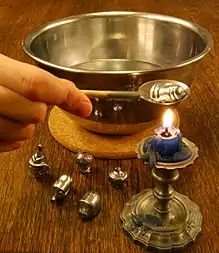Molybdomancy
Molybdomancy (from Ancient Greek μόλυβδος (molybdos), "lead"[1] and -mancy) is a technique of divination using molten metal. Typically, molten lead or tin is dropped into water. It can be found as a tradition in various cultures, including Austria, Bosnia and Herzegovina, Bulgaria, Germany, Finland, Estonia, Latvia, Switzerland, the Czech Republic and Turkey. Some versions have been found to have potentially harmful effects on human health.

.jpg.webp)
Method
Lead (or more recently tin) shapes are melted in a ladle over a flame, and the molten liquid is then poured into the water. The resulting shape is either directly interpreted as an omen for the future, or is rotated in a candlelight to create shadows, whose shapes are then interpreted. The shapes are interpreted symbolically, for example a bubbly surface signifying money, a fragile or broken shape misfortune. The shape of the lead before melting can refer to a specific area of one’s life. For example, ships for traveling, keys for career advancement, etc.[2]
Finland
In Finland, shops sell ladles and small bullions in the shape of a horseshoe for this express purpose. Originally made from tin, now they are made from cheaper low-melting alloys based on lead. The practice is known as uudenvuodentina. The world's largest uudenvuodentina, 41 kilograms (90 lb), was cast by members of the Valko volunteer fire department in Loviisa, Finland, in New Year 2010.[3][4]
The shapes are often interpreted not only literally, but also symbolically: a bubbly surface refers to money, a fragile or broken shape misfortune. Ships refer to travelling, keys to career advancement, a basket to a good mushroom year, and a horse to a new car.[5]
Germany, Austria, and Switzerland
Bleigießen (literally "lead pouring") is a traditional activity held at the New Year to predict the fortune of the coming year.[6] The different resulting shapes are identified based on their resemblance to any of various objects, animals, and structures, each with its own interpretation.[7] EU regulations passed in 2018 limit the sale of toxic lead-containing products, including molybdomancy kits. Alternatives involve dripping molten wax or tin rather than lead into water. In the Czech Republic molybdomancy is one of the traditional Christmas traditions. [8]
Turkey
.png.webp)
The tradition of molybdomancy is called "kurşun dökme" in Turkish (literally, "lead casting", "lead pouring") which is supposed to help with various spiritual problems, predict future, etc. The rituals vary, but they involve pouring molten lead into water.[9][10] Researchers from Ankara University performed a study of the effects of this tradition on the health of women. They reported risks of antimony poisoning and lead poisoning.[10]
A similar traditional practice is used in Bosnia and Herzegovina.[11]
See also
- Ceromancy, divination using molten wax rather than metal
- Methods of divination
Notes
- μόλυβδος, Henry George Liddell, Robert Scott, A Greek-English Lexicon, on Perseus
- https://www.rakentaja.fi/artikkelit/723/uudenvuoden_taikoja.htm
- "Maailman suurin uudenvuoden tina valettiin Loviisassa". iltalehti.fi. Retrieved 28 September 2015.
- Valkon VPK valoi maailman suurimman uudenvuoden tinan 41 kg. YouTube. 1 January 2010. Retrieved 28 September 2015.
- https://www.rakentaja.fi/artikkelit/723/uudenvuoden_taikoja.htm
- "Bleigießen – Lead Pouring". www.german-way.com. Retrieved 2019-01-02.
- "The German Custom of Bleigiessen". www.mrshea.com. Retrieved 12 April 2019.
- "Alternativen fürs Orakel-Gießen: Das erste bleifreie Silvester". Spiegel Online. 2018-12-31. Retrieved 2019-01-02.
- pp. 233 ff., Healing Secular Life: Loss and Devotion in Modern Turkey, Christopher Dole, University of Pennsylvania Press, 2012, ISBN 0812206355
- "Kurşun döktürmenin inanılmaz zararı", Milliyet (retrieved December 21, 2017)
- "Traditional Medicine in the Pristine Village of Prokoško Lake on Vranica Mountain, Bosnia and Herzegovina", Broza Šarić-Kundalić et al., Scientia Pharmaceutica 78, #2 (2010 June 30), pp. 275–290, doi:10.3797/scipharm.1003-06.
References
- de Givry, Grillot (1931). Witchcraft, magic & alchemy. Courier Dover Publications. p. 303. ISBN 0-486-22493-7.
- Cosman, Madeleine Pelner; Jones, Linda Gale. Handbook to life in the medieval world. Infobase Publishing. p. 434. ISBN 0-8160-4887-8.
| Wikimedia Commons has media related to Molybdomancy. |